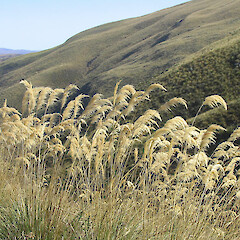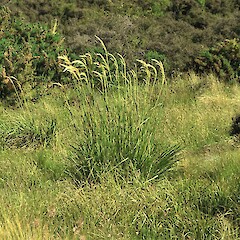Austroderia richardii
Common name
toetoe
Synonyms
Arundo richardii Endl.; Arundo kakao Steud.; Arundo australis A.Rich.; Gynerium zeelandicum Steud.; Cortaderia richardii (Endl.) Zotov
Family
Poaceae
Flora category
Vascular – Native
Endemic taxon
Yes
Endemic genus
Yes
Endemic family
No
Structural class
Grasses
NVS code
The National Vegetation Survey (NVS) Databank is a physical archive and electronic databank containing records of over 94,000 vegetation survey plots - including data from over 19,000 permanent plots. NVS maintains a standard set of species code abbreviations that correspond to standard scientific plant names from the Ngä Tipu o Aotearoa - New Zealand Plants database.
AUSRIC
Chromosome number
2n = 90
Current conservation status
The conservation status of all known New Zealand vascular plant taxa at the rank of species and below were reassessed in 2017 using the New Zealand Threat Classification System (NZTCS) – more information about this can be found on the NZTCS website. This report includes a statistical summary and brief notes on changes since 2012 and replaces all previous NZTCS lists for vascular plants.
Please note, threat classifications are often suggested by authors when publications fall between NZTCS assessment periods – an interim threat classification status has not been assessed by the NZTCS panel.
- Conservation status of New Zealand indigenous vascular plants, 2017 . 2018. Peter J. de Lange, Jeremy R. Rolfe, John W. Barkla, Shannel P. Courtney, Paul D. Champion, Leon R. Perrie, Sarah M. Beadel, Kerry A. Ford, Ilse Breitwieser, Ines Schönberger, Rowan Hindmarsh-Walls, Peter B. Heenan and Kate Ladley. Department of Conservation. Source: NZTCS and licensed by DOC for reuse under the Creative Commons Attribution 4.0 International licence.
2017 | Not Threatened
Previous conservation statuses
2012 | Not Threatened
2009 | Not Threatened
2004 | Not Threatened
Distribution
Endemic. Confined to the South Island. Possibly in the North Island, east of Cape Palliser. Naturalised in Tasmania.
Habitat
Abundant, from the coast to subalpine areas. Common along stream banks, river beds, around lake margins, and in other wet places. Also found in sand dunes, especially along the Foveaux Strait.
Wetland plant indicator status rating
Information derived from the revised national wetland plant list prepared to assist councils in delineating and monitoring wetlands (Clarkson et al., 2021 Manaaki Whenua – Landcare Research Contract Report LC3975 for Hawke’s Bay Regional Council). The national plant list categorises plants by the extent to which they are found in wetlands and not ‘drylands’. The indicator status ratings are OBL (obligate wetland), FACW (facultative wetland), FAC (facultative), FACU (facultative upland), and UPL (obligate upland). If you have suggestions for the Wetland Indicator Status Rating, please contact: [Enable JavaScript to view protected content]
FAC: Facultative
Commonly occurs as either a hydrophyte or non-hydrophyte (non-wetlands).
Detailed description
Tall, gracile, slender tussock-forming grass up to 3 m tall when flowering. Leaf-sheath glabrous, green, covered in white wax. Ligule 3.5 mm. Collar brown, basally glabrous, upper surface with short, stiff hairs surmounting ribs. Leaf-blade 2–3 × 0.25 m, green, dark-green, often somewhat glaucous, upper side with thick weft of hairs at base, otherwise sparsely hairy up midrib with abundant, minute prickle teeth throughout; undersurface with 5 mm long hairs near leaf margins, otherwise harshly scabrid. Culm up to 3 m, inflorescence portion up to 1 m tall, pennant-shaped, drooping, narrowly plumose. Spikelets numerous, 25 mm with 3 florets per spikelet. Glumes equal, > or equal to florets, 1- or 3-nerved. Lemma 10 mm, scabrid. Palea 6 mm, keels ciliate. Callus hairs 2 mm. Rachilla 1 mm, glabrous. Flowers either perfect (anthers 4.5 mm) or female (3 mm). Ovary of perfect flowers 1 mm, stigma-styles 2.5 mm; ovary of female flowers 1.3 mm, stigma-style 4 mm. Seed 3–4 mm.
Manaaki Whenua Online Interactive Key
Similar taxa
Closest to Austroderia toetoe from which it is best distinguished by the green rather than ivory leaf-sheaths, and by the green rather than ivory culm internodes. Also recognisable by the very slender, gracile leaves, culms and inflorescences. The inflorescences in this species are rather beautiful and resemble fine, narrow, pennants. Around the Foveaux Strait area and at Mason Bay, Stewart Island, some populations of A. richardii are distinctly rhizomatous.
Flowering
September–November
Fruiting
October–March
Life cycle
Florets are wind dispersed (Thorsen et al., 2009).
Propagation technique
Easily grown from fresh seed (as a revegetation exercise ripe seed heads can be pinned to soil surface, and if kept damp, soon germinate) and division of established plants.
Threats
Abundant and not threatened. Often naturalising in suitable habitats.
Etymology
richardii: Named after Achille Richard (1794-1852) - a French botanist who described several New Zealand plant species
Where To Buy
Commonly cultivated in the South Island, and offered by many specialist native plant nurseries. Not commonly cultivated in the North Island.
Attribution
Fact sheet prepared for NZPCN by P.J. de Lange 1 October 2006. Description adapted from Edgar & Connor (2000).
References and further reading
Edgar E, Connor HE. 2000. Flora of New Zealand. Vol. V. Grasses. Christchurch, Manaaki Whenua Press. 650 p.
Thorsen MJ, Dickinson KJM, Seddon PJ. 2009. Seed dispersal systems in the New Zealand flora. Perspectives in Plant Ecology, Evolution and Systematics 11: 285–309.
NZPCN Fact Sheet citation
Please cite as: de Lange, P.J. (Year at time of access): Austroderia richardii Fact Sheet (content continuously updated). New Zealand Plant Conservation Network. https://www.nzpcn.org.nz/flora/species/austroderia-richardii/ (Date website was queried)










